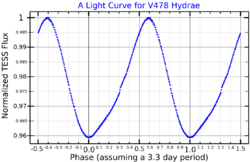Astronomy:HD 70573
| Observation data Equinox J2000.0]] (ICRS) | |
|---|---|
| Constellation | Hydra |
| Right ascension | 08h 22m 49.95277s[2] |
| Declination | +01° 51′ 33.5522″[2] |
| Apparent magnitude (V) | 8.66-8.77[3] |
| Characteristics | |
| Evolutionary stage | main sequence |
| Spectral type | G1/2V[4] |
| B−V color index | 0.59[5] |
| Variable type | BY Dra[3] |
| Astrometry | |
| Radial velocity (Rv) | 20.16±0.22[2] km/s |
| Proper motion (μ) | RA: −51.362±0.017[2] mas/yr Dec.: −49.047±0.013[2] mas/yr |
| Parallax (π) | 16.9267 ± 0.0168[2] mas |
| Distance | 192.7 ± 0.2 ly (59.08 ± 0.06 pc) |
| Absolute magnitude (MV) | +0.4[6] |
| Details | |
| Mass | 1.0±0.1[6] M☉ |
| Radius | 0.98+0.01 −0.03[7] R☉ |
| Luminosity | 0.998±0.004[7] L☉ |
| Surface gravity (log g) | 4.59±0.10[6] cgs |
| Temperature | 5,837+80 −51[7] K |
| Metallicity [Fe/H] | −0.18±0.20[6] dex |
| Rotation | 3.296 days[6] |
| Rotational velocity (v sin i) | 14.7±1.0[6] km/s |
| Age | 2.3±2.1[8] Gyr |
| Other designations | |
| Database references | |
| SIMBAD | data |
HD 70573 is a variable star in the equatorial constellation of Hydra. At a mean apparent visual magnitude of +8.7, this yellow-hued star is too dim to be visible to the naked eye. Based upon parallax measurements, it is located at a distance of 193 light years from the Sun, and is drifting further away with a radial velocity of 20.5 km/s. It is a candidate member of the proposed Hercules-Lyra Association of co-moving stars,[5] although this membership is disputed.[10]
This is a G-type main-sequence star with a stellar classification of G1/2V.[4] It is a BY Draconis variable that ranges in brightness from magnitude 8.66 down to 8.77 with a rotationally-modulated period of 3.296 days.[3] HD 70573 is generally considered to be a young star although estimates of its age vary from 60[11] million years to several billion years.[8] It has a projected rotational velocity of 15 km/s[6] and about the same mass, size, and luminosity as the Sun.
Planetary system
On March 19, 2007, an extrasolar planet was announced, having been discovered by the radial velocity method. As of 2007, this was the youngest host star discovered to have an orbiting planet.[6] However, a follow-up study by Soto et al. in 2015 failed to detect the planetary signal, so it remains unconfirmed.[12]
The system displays an infrared excess, which matches the black body signature of a debris disk orbiting 21.8 astronomical unit|AU from the host star with a mean temperature of 60 K.[13]
| Companion (in order from star) |
Mass | Semimajor axis (AU) |
Orbital period (days) |
Eccentricity | Inclination | Radius |
|---|---|---|---|---|---|---|
| b (unconfirmed) | ≥6.1±0.4 MJ | 1.76±0.05 | 851.8±11.6 | 0.4±0.1 | — | — |
References
- ↑ "MAST: Barbara A. Mikulski Archive for Space Telescopes". Space Telescope Science Institute. https://mast.stsci.edu/portal/Mashup/Clients/Mast/Portal.html.
- ↑ Jump up to: 2.0 2.1 2.2 2.3 2.4 Vallenari, A. et al. (2022). "Gaia Data Release 3. Summary of the content and survey properties". Astronomy & Astrophysics. doi:10.1051/0004-6361/202243940 Gaia DR3 record for this source at VizieR.
- ↑ Jump up to: 3.0 3.1 3.2 Samus, N. N. et al. (2017). "General Catalogue of Variable Stars". Astronomy Reports. 5.1 61 (1): 80–88. doi:10.1134/S1063772917010085. Bibcode: 2017ARep...61...80S.
- ↑ Jump up to: 4.0 4.1 Houk, N.; Swift, C. (1999). "Michigan catalogue of two-dimensional spectral types for the HD Stars". Michigan Spectral Survey 5. Bibcode: 1999MSS...C05....0H.
- ↑ Jump up to: 5.0 5.1 López-Santiago, J. et al. (2006). "The Nearest Young Moving Groups". The Astrophysical Journal 643 (2): 1160–1165. doi:10.1086/503183. Bibcode: 2006ApJ...643.1160L.
- ↑ Jump up to: 6.0 6.1 6.2 6.3 6.4 6.5 6.6 6.7 6.8 Setiawan et al. (2007). "Evidence for a Planetary Companion around a Nearby Young Star". The Astrophysical Journal Letters 660 (2): L145–L148. doi:10.1086/518213. Bibcode: 2007ApJ...660L.145S.
- ↑ Jump up to: 7.0 7.1 7.2 Brown, A. G. A. (August 2018). "Gaia Data Release 2: Summary of the contents and survey properties". Astronomy & Astrophysics 616: A1. doi:10.1051/0004-6361/201833051. Bibcode: 2018A&A...616A...1G. Gaia DR2 record for this source at VizieR.
- ↑ Jump up to: 8.0 8.1 Llorente de Andrés, F.; Chavero, C.; de la Reza, R.; Roca-Fàbrega, S.; Cifuentes, C. (October 2021). "The evolution of lithium in FGK dwarf stars. The lithium-rotation connection and the Li desert". Astronomy and Astrophysics 654: A137. doi:10.1051/0004-6361/202141339. ISSN 0004-6361. Bibcode: 2021A&A...654A.137L.
- ↑ "HD 70573". SIMBAD. Centre de données astronomiques de Strasbourg. http://simbad.u-strasbg.fr/simbad/sim-basic?Ident=HD+70573.
- ↑ Eisenbeiss, T. et al. (August 2013). "The Hercules-Lyra association revisited. New age estimation and multiplicity study". Astronomy & Astrophysics 556: 19. doi:10.1051/0004-6361/201118362. A53. Bibcode: 2013A&A...556A..53E.
- ↑ Meshkat, Tiffany et al. (December 2017). "A Direct Imaging Survey of Spitzer-detected Debris Disks: Occurrence of Giant Planets in Dusty Systems". The Astronomical Journal 154 (6): 21. doi:10.3847/1538-3881/aa8e9a. 245. Bibcode: 2017AJ....154..245M.
- ↑ Soto, M. G. et al. (August 2015). "RAFT - I. Discovery of new planetary candidates and updated orbits from archival FEROS spectra". Monthly Notices of the Royal Astronomical Society 451 (3): 3131–3144. doi:10.1093/mnras/stv1144. Bibcode: 2015MNRAS.451.3131S.
- ↑ Cotten, Tara H.; Song, Inseok (July 2016). "A Comprehensive Census of Nearby Infrared Excess Stars". The Astrophysical Journal Supplement Series 225 (1): 24. doi:10.3847/0067-0049/225/1/15. 15. Bibcode: 2016ApJS..225...15C.
External links
- "Notes for star HD 70573". Extrasolar Planets Encyclopaedia. http://exoplanet.eu/star.php?st=HD+70573.
Coordinates: ![]() 08h 22m 49.9514s, +01° 51′ 33.552″
08h 22m 49.9514s, +01° 51′ 33.552″
 |


